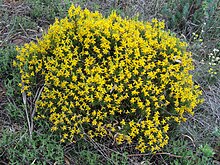Genistoids
| Genistoids Temporal range:
| |
|---|---|

| |
| Genista hirsuta | |
| Scientific classification | |
| Kingdom: | Plantae |
| Clade: | Tracheophytes |
| Clade: | Angiosperms |
| Clade: | Eudicots |
| Clade: | Rosids |
| Order: | Fabales |
| Family: | Fabaceae |
| Subfamily: | Faboideae |
| Clade: | Meso-Papilionoideae |
| Clade: | Genistoids Wojciechowski et al. 2004[2][3] |
| Tribes[8][9] | |
| |
| Synonyms | |
| |
The Genistoids are one of the major radiations in the plant family Fabaceae. Members of this phylogenetic clade are primarily found in the Southern hemisphere.[2][8][9] Some genera are pollinated by birds.[8] The genistoid clade is consistently resolved as monophyletic in molecular phylogenetic analyses.[2][8][9][11][12][13][14][15] It is estimated to have arisen 56.4 ± 0.2 million years ago (in the Paleocene).[12] A node-based definition for the genistoids is: "the MRCA of Poecilanthe parviflora and Lupinus argenteus."[2] One morphological synapomorphy has been tentatively identified: production of quinolizidine alkaloids.[2][16][17][18] Some genera also accumulate pyrrolizidine.[8][9] A new genus, to be segregated from Clathrotropis, has also been proposed to occupy an undetermined position within the genistoid clade.[8][9]
Core Genistoids[edit]
The core genistoids, also known as the genistoids sensu stricto, comprise most of the tribes of the genistoids sensu lato, and are found mainly in Africa and Eurasia.[9] This subclade is also consistently resolved as monophyletic.[2][8][9][4][11][12][13] A node-based definition for the core genistoids is: "the MRCA of Bolusanthus speciosus and Spartium junceum."[2]
Systematics[edit]
Modern molecular phylogenetics suggest the following relationships:[5][7][9]
References[edit]
- ^ "Fabales". www.mobot.org. Retrieved 2023-06-16.
- ^ a b c d e f g Wojciechowski MF, Lavin M, Sanderson MJ (2004). "A phylogeny of legumes (Leguminosae) based on analysis of the plastid matK gene resolves many well-supported subclades within the family". Am J Bot. 91 (11): 1846–1862. doi:10.3732/ajb.91.11.1846. PMID 21652332.
- ^ Wojciechowski MF (2013). "Towards a new classification of Leguminosae: Naming clades using non-Linnaean phylogenetic nomenclature". S Afr J Bot. 89: 85–93. doi:10.1016/j.sajb.2013.06.017.
- ^ a b Crisp MD, Gilmore S, Van Wyk B-E (2000). "Molecular phylogeny of the genistoid tribes of papilionoid legumes". In Herendeen PS, Bruneau A (eds.). Advances in Legume Systematics, Part 9. Royal Botanic Gardens, Kew. pp. 249–276. ISBN 978-1842460177.
- ^ a b Cardoso D, Harris DJ, Wieringa JJ, São-Mateus WMB, Batalha-Filho H, Torke BM, Prenner G, de Queiroz LP (2017). "A molecular-dated phylogeny and biogeography of the monotypic legume genus Haplormosia, a missing African branch of the otherwise American-Australian Brongniartieae clade". Molecular Phylogenetics and Evolution. 107: 431–442. doi:10.1016/j.ympev.2016.12.012. PMID 27965083.
- ^ Swanepoel W, le Roux MM, Wojciechowski MF, van Wyk AE (2015). "Oberholzeria (Fabaceae subfam. Faboideae), a New Monotypic Legume Genus from Namibia". PLOS ONE. 10 (3): e0122080. Bibcode:2015PLoSO..1022080S. doi:10.1371/journal.pone.0122080. PMC 4376691. PMID 25816251.
- ^ a b Castellanos C, Lewis GP, Banks H, Steeves R, Bruneau A (2016). "A settled sub-family for the orphan tree: The phylogenetic position of the endemic Colombian genus Orphanodendron in the Leguminosae". Brittonia. 69: 1–9. doi:10.1007/s12228-016-9451-3. S2CID 43040112.
- ^ a b c d e f g Cardoso D, de Queiroz LP, Pennington RT, de Lima HC, Fonty É, Wojciechowski MF, Lavin M (2012). "Revisiting the phylogeny of papilionoid legumes: new insights from comprehensively sampled early-branching lineages". Am J Bot. 99 (12): 1991–2013. doi:10.3732/ajb.1200380. PMID 23221500.
- ^ a b c d e f g h Cardoso D, Pennington RT, de Queiroz LP, Boatwright JS, Van Wyk B-E, Wojciechowski MF, Lavin M (2013). "Reconstructing the deep-branching relationships of the papilionoid legumes". S Afr J Bot. 89: 58–75. doi:10.1016/j.sajb.2013.05.001.
- ^ Polhill RM (1981). "Papilionoideae". In Polhill RM, Raven PH (eds.). Advances in Legume Systematics, Parts 1 and 2. Royal Botanic Gardens, Kew. pp. 191–208. ISBN 9780855212247.
- ^ a b LPWG [Legume Phylogeny Working Group] (2013). "Legume phylogeny and classification in the 21st century: progress, prospects and lessons for other species-rich clades" (PDF). Taxon. 62 (2): 217–248. doi:10.12705/622.8. hdl:10566/3455.
- ^ a b c Lavin M, Herendeen PS, Wojciechowski MF (2005). "Evolutionary rates analysis of Leguminosae implicates a rapid diversification of lineages during the tertiary". Syst Biol. 54 (4): 575–94. doi:10.1080/10635150590947131. PMID 16085576. S2CID 39186425.
- ^ a b McMahon MM, Sanderson MJ (2006). "Phylogenetic supermatrix analysis of GenBank sequences from 2228 papilionoid legumes". Syst Biol. 99 (12): 1991–2013. doi:10.1080/10635150600999150. PMID 17060202.
- ^ Pennington RT, Lavin M, Ireland H, Klitgaard B, Preston J, Hu JM (2001). "Phylogenetic relationships of basal papilionoid legumes based upon sequences of the chloroplast trnL intron". Syst Bot. 55 (5): 818–836. doi:10.1043/0363-6445-26.3.537 (inactive 31 January 2024).
{{cite journal}}: CS1 maint: DOI inactive as of January 2024 (link) - ^ Doyle JJ, Doyle JL, Ballenger JA, Dickson EE, Kajita T, Ohashi H (1997). "A phylogeny of the chloroplast gene rbcL in the Leguminosae: taxonomic correlations and insights into the evolution of nodulation". Am J Bot. 84 (4): 541–554. doi:10.2307/2446030. JSTOR 2446030. PMID 21708606.
- ^ Kinghorn AD, Hussain RA, Robbins EF, Balandrin MF, Stirton CH, Evans SV (1988). "Alkaloid distribution in seeds of Ormosia, Pericopsis and Haplormosia". Phytochemistry. 27 (2): 439–444. doi:10.1016/0031-9422(88)83116-9.
- ^ Van Wyk B-E. (2003). "The value of chemosystematics in clarifying relationships in the Genistoid tribes of papilionoid legumes". Biochem Syst Ecol. 31 (8): 875–884. Bibcode:2003BioSE..31..875V. doi:10.1016/S0305-1978(03)00083-8.
- ^ Wink M, Mohamed GI (2003). "Evolution of chemical defense traits in the Leguminosae: mapping of distribution patterns of secondary metabolites on a molecular phylogeny inferred from nucleotide sequences of the rbcL gene". Biochem Syst Ecol. 31 (8): 897–917. Bibcode:2003BioSE..31..897W. doi:10.1016/S0305-1978(03)00085-1.
